Off grid solar power system on an RV (Recreational Vehicle) or motorhome - Page 2
|
|
|
|
Table of Contents
The parts to be installed (on page 1)
Figuring out where to put things and mounting the inverter, E-Panel and charge controller (on page 1)
Wiring the solar panels and running the cable into the E-Panel (on page 2)
The AC wiring and making a 240VAC outlet work with a 120VAC inverter (on page 3)
Wiring the Outback turbo fan for sealed inverters (on page 3)
The battery bank, battery temperature sensor and venting (on page 3)
Powering DC Loads (on page 4)
Controlling and monitoring - Outback Mate (on page 4)
Wiring the solar panels and running the cable into the E-Panel
There were six Kyocera KC175GT solar/photovoltaic panels with these
specifications needed for the calculations below...
Maximum power voltage: 23.6 volts
Short circuit current: 8.58 amps
These were already installed so all I had to do was wire them together in some manner that made sense with the rest of the system and run a cable from the roof to the front storage compartment where the rest of the system was located.
The hotter a solar panel gets the less power it produces so they had to be mounted with space for air to flow behind them. To do this, four aluminum legs were attached to near the corners as shown in the photo on the right. They couldn't be too low because the curvature of the roof meant that if the sides were up, the middle might still be too low. So the sides had to be higher than they needed to be. The legs were both glued and screwed to the rubber roof.
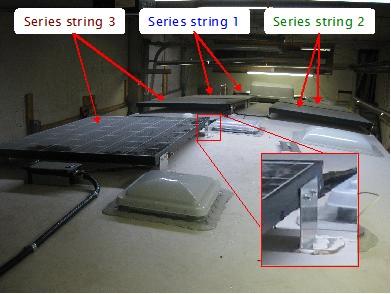

The customer would be parking in a lot of campgrounds where there would be trees nearby. Even a small amount of shading on a solar panel significantly decreases the amount of power that panel outputs. Not only that, but any other panels that are connected with it in series (positive connected to negative) are also adversely affected. In this case, ideally there would be no series connections at all. Instead, all solar panels would be connected directly/individually to the charge controller. Another way of saying this is that they'd all be connected in parallel (all positives together and all negatives together.)
However, connecting all six in parallel would have been too much short circuit current for the FLEXmax 80 charge controller, which is limited to 64 amps. From the specifications for these panels the short circuit current is 8.58 amps. There are six panels and when they're all connected in parallel this current is multiplied by six, so 51.48 amps. But, we also add an extra 25% above these rated values since the ratings come from specific labratory conditions that are not necessarily the best case scenario. So 51.48 amps multiplied by 1.25 gives a possible output of 64.35 amps, a little too close to the FLEXmax 80's rated maximum of 64 amps.
So the next best we could do was to connect them in three sets of two panels in series (see wiring diagram above), selecting pairs of panels that were close together under the assumption that if two panels are shaded by the same tree then those panels would be close together. Current doesn't add up in series, so the output current for two panels in series is 8.58 amps. Then three of these series strings are connected in parallel in the E-Panel so we have 3 multiplied by 8.58 multiplied by 1.25 for a total of 32.18 amps. The FLEXmax 80 can handle this just fine.
Grounding the solar panels and taping the wires down
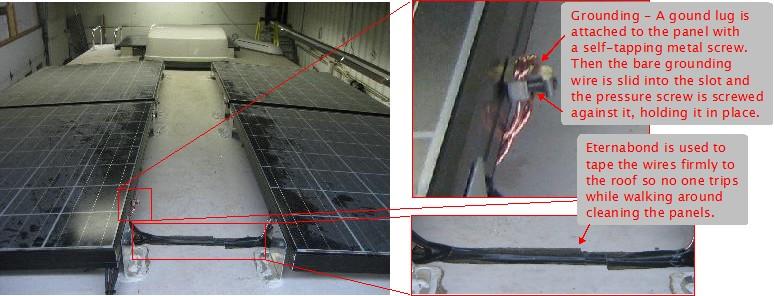
The frames of all the solar panels had to be connected with a bare ground wire (see yellow line in the wiring diagram above.) If there is a short circuit in the panels to their frames causing the frames to be electrified, we don't want anyone to be shocked from touching the frames. So we ground them. To do this, a ground lug (see photo above) is screwed to each frame and a common bare wire is connected to all the lugs. This ground wire is run down to the E-Panel along with all the other solar array wires. If there is a short circuit, the electricity will take the easy path to ground instead (typically the vehicle's metal frame.)
Also, the customer will be climbing up to the roof frequently to clean the panels. To reduce the chance of him tripping on any wiring, some wires were taped firmly down to the roof with Eternabond as shown in the photo above. Ideally they would also have a solid casing over them in case he walks on them too.
As the wires run the length of the panels, they are firmly strapped to the underside of the frame. This was done by drilling holes in the sides of the frames and inserting ties through the holes that securely bundled the wires in place with the frame. This prevents the wires from flapping around while the vehicle is in motion.
Connecting all the wires to the cable
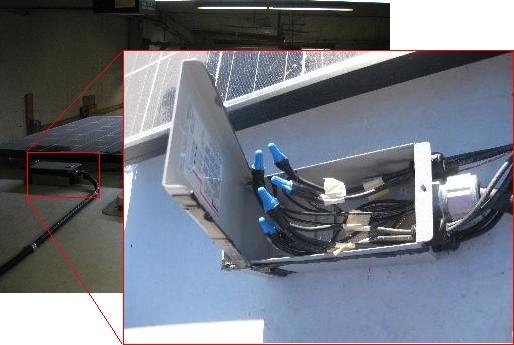
Many solar systems have a box called a combiner box where positives are all connected together and negatives are all connected together in parallel along with some breakers for the positive connections. We didn't want to do this because if a breaker tripped then the customer would have to climb up to the roof to reset it.
Instead we had just a sealed connection box (see photo above) where all the positives and negatives from the panels entered and were individually connected to wires in a single cable. This cable has eight insulated wires, numbered one through eight with the numbers written on the insulation on their entire length. So the positive wires from the panels were connected to wires one, three, and five in the cable and the negative wires were connected to two, four, and six. The cable was then run through the home to the E-Panel in the front storage compartment. So the three series strings (see the Solar array wiring diagram above) remained as three series strings all the way down to the E-Panel to be paralleled there instead. The breaker is also in the E-Panel.
There was also a bare ground wire in this cable. The bare ground wire that was connected to all the solar panel frames was connected to this wire.
Wire sizing
Two things need to be checked regarding wire sizing, ampacity and voltage drop. Ampacity ensures that the wire won't heat up, melt and cause a fire. Voltage drop ensures that the losses won't be too large.
From the above, each wire in the cable going down to the E-Panel would have 8.58 amps multiplied by 1.25, or 10.725 amps going through it. From looking in an ampacity table for copper wire in a cable, 14AWG wire would be fine for handling 10.725 amps (14AWG is rated for up to 15 amps.) This cable had 12AWG wire which is even thicker so it would do fine.
Since each wire is fed by a 2-solar panel series string, the voltage would be 23.6V multiplied by 2, or 47.2V. From looking in a DC voltage drop table for a cable run of 24 feet, at 35C (95F), for a copper conductor in an aluminium jacketted cable with 4 parallel sets of wires, the voltage would drop 0.5%. 0.5% of 47.2V is a negligible amount to lose and so this cable meets both the ampacity and voltage drop requirements.
Running the cable through the home to the E-Panel
The cable was about 1 inch in diameter and was metal jacketted with a UV protected outer plastic cover. Single or double sided Eternabond was used to seal where screws and the cable itself penetrated the roof. This was all later covered with a special caulking for rubber roofs.
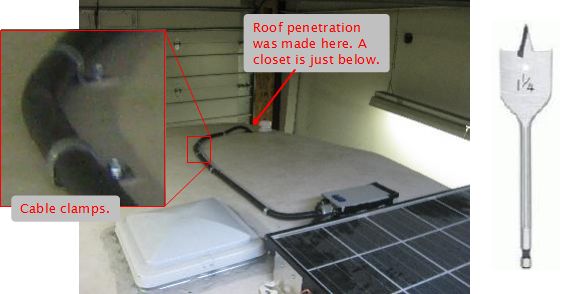
The roof itself was about 2 1/2" thick, consisting of the rubber outside, the molded shell, insulation and then wood in the closet. A pilot hole was made first from inside the closet (see photo below), upwards, with a normal 5/16" drill bit followed by the main hole using a 1 1/4" spade bit. For penetrating the floor in the dresser, rough measurements were made first as there was some steel framing in the ceiling of the small battery storage compartment. A pilot hole was then made followed by the spade bit. In all other penetrations, only the spade bit was needed.
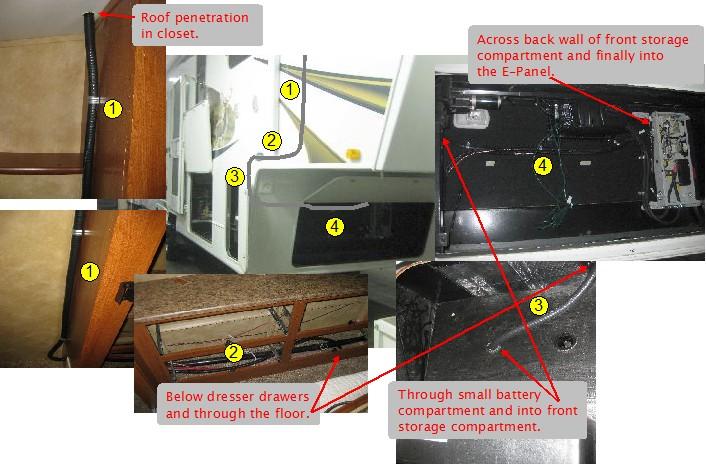
Wiring the solar into the E-Panel and charge controller and on to the batteries
The cable from the roof was inserted into the E-Panel. Then the E-Panel door with the charge controller mounted on it was put in place.
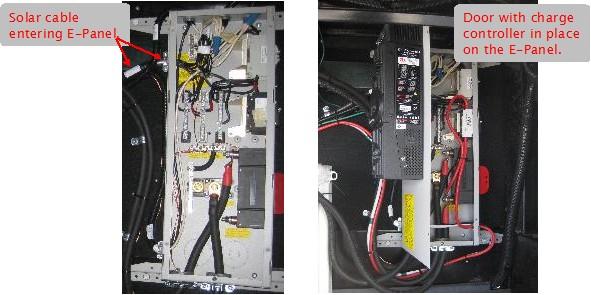
The following is the wiring diagram for the wiring once it has arrived from the roof into the E-Panel and is run through various disconnect switches/breakers through the charge controller and ultimately to the batteries. Photos of the actual wiring follow.
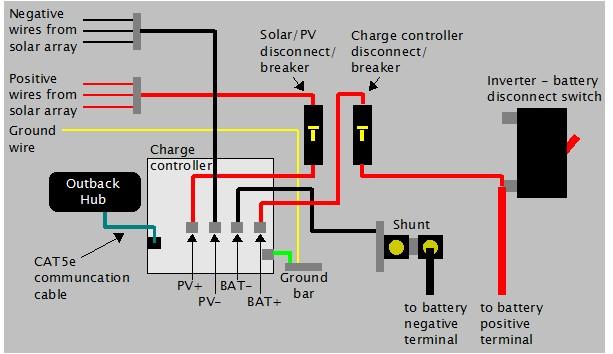
The three negative wires in the cable from the three series strings of solar panels (see 1a, 1b, 1c in photo below) were too much to combine in the lug in the charge controller so a busbar was added to the E-Panel for combining the negatives in one place. A single 6 AWG wire was then run from the busbar and into the charge controller. This connected the three negatives in parallel.
The three positive wires needed to go to a disconnect switch/breaker so again, they were first combined using a busbar (see 2a, 2b, 2c in photo.) This time one didn't need to be added. Because a Mobile version of an Outback inverter was being used, the AC neutral busbar was not needed so this was co-opted as a positive busbar. A single 6 AWG wire was then run from the busbar to the disconnect switch and then another from the disconnect switch to the charge controller.
And lastly, the bare ground wire from the cable was connected to the E-Panel's ground busbar (see 3 in the photo.)
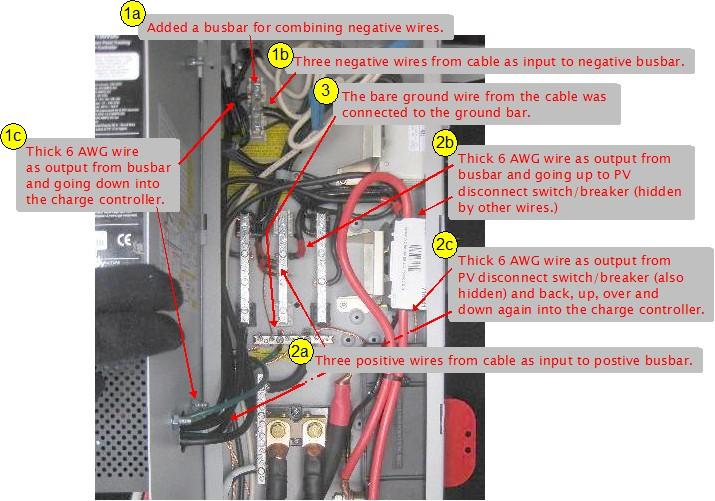
Next was the wiring for the output from the charge controller. First a wire for the negative output (see 1 in the photo below) going to the battery was run from the charge controller to the shunt busbar, the other side of which has the battery's negative cable connected to it.
The positive output (see 2 in the photo) was first run up to a disconnect switch/breaker and from there down to a bolt to which the battery's positive cable was attached.
To ground the charge controller case, a wire was connected from the charge controller to the E-Panel's ground bar (see 3 in photo.)
And lastly, a CAT5e communication cable with RJ45 connectors was run from the charge controller, through the E-Panel and out to the Outback Hub.
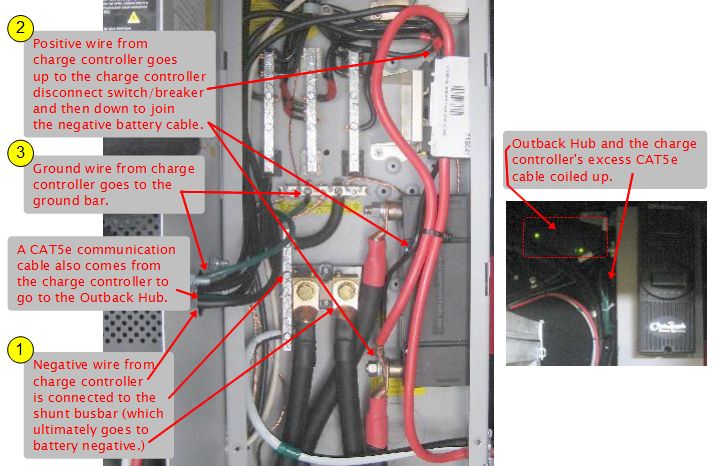
Unfortunately I was too busy doing the installation to think to take a photo of the wiring inside the charge controller. So here is a black and white photo taken from the manual instead. Note that the wiring I did went through the indicated hole, and back into the E-Panel, unlike the wiring in the photo below.
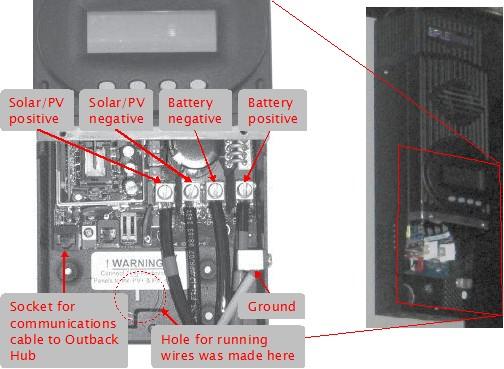
I would have preferred to tie strap together and secure more wires in the E-Panel to make a neater job but I was working with fairly stiff stranded 6AWG wire. In order to be able to have the E-Panel door close without causing too much stress on the lugs in the charge controller I had to leave some looseness to the wiring in the E-Panel. I did at least keep the routing consistent and avoided having wires come in contact with bare parts.
Wire sizing
In the above wiring we had three set of wires coming down the cable from the roof to the busbars in the E-Panel. That connects the wires in parallel. From those busbars, 6AWG wire was used. As already stated, when connecting things in parallel the current adds and the voltage stays the same. Each wire could have 10.725 amps (8.58 amps multiplied by 1.25). 10.725 amps multiplied by 3 is 32.18 amps. From looking in an ampacity table for copper wire in free air (i.e. not in a cable), 10AWG wire would handle this just fine. I had both 10AWG and 6AWG on hand and decided to go with added safety and use the thicker 6AWG instead.
Voltage drop was not a consideration in this case since the distance from the busbars to the disconnect breaker and charge controller was so short.
|
|
|
|
